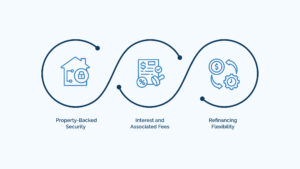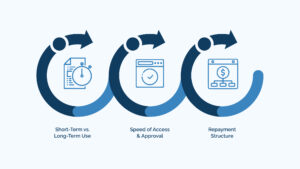When purchasing a property, most people immediately think of a mortgage. Regular commercial real estate (CRE) loans have long been the standard for financing property acquisitions, offering structured repayment terms and predictable rates. Yet, 67% of borrowers express dissatisfaction with their mortgage experience, often citing delays and complexity as key frustrations.
In a competitive market, time is often a critical factor. Consider a scenario where a well-located commercial space becomes available at a below-market price. You recognize the value instantly, but so do others. A conventional loan might take weeks to finalize, causing you to miss out.
Bridge loans provide quick loans for such situations. But is it the right solution for you?
In this blog, we’ll break down the differences between bridge loans and mortgage financing, what each offers, where they fall short, and how to choose the right one based on your strategy, timeline, and risk.
What Is a Bridge Loan?
| A bridge loan is a short-term financing option that helps investors quickly secure capital to purchase or renovate a property. Bridge loans focus on the asset’s value rather than the borrower’s credit history or income. |
A bridge loan mortgage offers speed and flexibility, making it ideal for situations where timing is critical, like competitive auctions or urgent property acquisitions. They provide a financial “bridge” that fills gaps between transactions or financing stages, enabling investors to act fast without waiting for the slower mortgage approval process.
What Is a Mortgage?
| A mortgage is a long-term loan used to finance the purchase of real estate. It’s repaid over 15 to 30 years through fixed monthly payments that include both principal and interest. |
Mortgages are heavily dependent on the borrower’s financial profile, credit score, income stability, and debt-to-income ratio, all of which play a significant role in approval.
Mortgages offer predictability and lower interest rates, but they come with longer processing times, extensive documentation, and stricter qualification requirements. They’re best suited for stable, long-term property investments where timing isn’t a constraint.
Similarities Between Mortgages & Bridging Finance

While they serve different purposes, bridging loans and mortgages do share a few structural similarities. Recognizing these can help you better compare which solution aligns with your goals.
1. Property-Backed Security
Both loans are secured against real estate, using the property as collateral. This security reduces the lender’s risk and can make it easier to access larger loan amounts compared to unsecured credit. If the borrower defaults, the property can be sold to recover the debt.
2. Interest and Associated Fees
Whether it’s a bridge loan or mortgage, the total cost includes interest and lender fees. These may differ in structure, but bridge loans often involve interest-only payments or rolled-up interest. Both options require you to pay more than the principal amount borrowed.
3. Refinancing Flexibility
Each type of financing can be refinanced if your situation evolves. Whether you’re restructuring a bridge loan into a long-term mortgage or refinancing an existing mortgage, both allow flexibility, though additional costs may apply.
Bridge Loan vs Mortgage Differences That Impact Your Deal

Understanding the distinctions between a bridge loan and a mortgage can help you select the right financing tool for your commercial property goals.
1. Short-Term vs. Long-Term Use
Bridge loans are short-term solutions, lasting 6 to 18 months, while traditional mortgages span much longer terms, often 15 to 30 years. Bridge financing is ideal when you need fast funding to secure a property or cover a gap before selling another asset or locking in permanent funding. Mortgages, on the other hand, are built for stability and long-term ownership.
2. Speed of Access & Approval
One of the biggest advantages of a bridge loan is how quickly it can be approved, often within days. Mortgage pre-approval, by contrast, involves a much more detailed process that can take weeks. This speed makes bridge loans highly effective in competitive markets where hesitation means missing out.
3. Repayment Structure
Bridge loans rely on an “exit strategy,” such as selling the property or refinancing it, to repay the balance. Payments may be deferred or interest-only during the loan term. Mortgages, however, require consistent monthly payments that reduce the principal over time.
Comparing a bridge loan vs. a second mortgage also highlights this distinction. Second mortgages come with monthly obligations, while bridge loans offer more short-term flexibility.
| Feature | Bridge Loan | Mortgage |
| Use Cases | Purchasing before selling, quick closings, and renovation projects | Long-term property ownership, stability, and equity building |
| Interest Rates | Higher due to short-term and lender risk | Lower, especially with strong credit and financials |
| Loan Amount Flexibility | Often more flexible, based on asset value | Stricter caps based on income, credit, and property appraisal |
| Documentation Requirements | Fewer documents and less financial scrutiny | Extensive paperwork and income verification |
| Lien Position | Often used as a first or second lien | Generally, a first lien on the property |
| Use of Funds | Can be used for a range of short-term needs | Primarily for the purchase or refinance of property |
Comparing Bridging Loans vs Mortgage Interest Rates
While both financing options come with interest charges, the way those costs behave and how they affect your bottom line can vary significantly.
| Cost Element | Bridge Loan | Mortgage |
| Interest Rate Type | Typically higher, often fixed or rolled into the loan total | Lower, usually fixed or variable, depending on the lender and product |
| Interest Accrual | May accrue monthly | Paid monthly, along with principal in most cases |
| Upfront Fees | Arrangement, valuation, and legal fees are often paid upfront | May include origination, appraisal, and processing fees |
| Exit Fees | Common | Rare |
| Loan Duration Impact | Shorter term means interest adds up quickly, despite fewer months | Longer duration lowers the monthly cost, but the average mortgage rate may increase the total interest |
| Total Cost Over Time | Higher short-term cost, but potentially lower total outlay if repaid fast | Lower monthly cost, but higher total repayment due to longer term |
Even though bridging loans come with steeper interest rates, they’re often used for situations where timing outweighs long-term cost. Mortgages, while cheaper on paper, can lead to larger cumulative interest payments over the years, especially if prepayment isn’t an option.
Why Choose Bridging Finance Instead of a Mortgage?
Bridging finance isn’t a substitute for a mortgage, but rather it’s a different solution built for various circumstances. While mortgages are structured for long-term repayment, bridging loans are designed to meet financing needs where timing and flexibility are critical.
In many cases, a bridge loan serves as the first step in a broader financing strategy, providing fast access to capital while a traditional mortgage is still being arranged. So, it’s often not a matter of “bridge loan vs mortgage,” but rather “bridge loan, then mortgage.”
Understanding Exit Strategies in Bridging Finance
An exit strategy is a predefined plan for how the loan will be repaid and is agreed upon before the funds are released. It’s one of the most essential components of a bridging loan application and gives the lender confidence that repayment will happen on time.
Common exit strategies include:
Securing a Mortgage: If you plan to retain the property, a mortgage can be arranged after the bridging finance gives you time to apply. This could be a standard residential mortgage or a buy-to-let mortgage, depending on how the property will be used. The new mortgage pays off the bridge loan in full. It’s a kind of mortgage insurance for you.
Selling the Property: If the property is being renovated or developed for resale, such as in a flip project, proceeds from the sale are used to repay the loan. This is a common route for real estate investors.
Selling a Different Property: In cases where you buy a new home before your current one sells, you can use bridging finance to move forward without delay. Once the original property is sold, the proceeds are used to clear the bridge loan.
A well-planned exit strategy is essential to getting approved and ensuring the bridge loan interest rates fit within your broader financial plans.
Start Your Next Property Deal with Smart Financing from Bluestone

Bridging loans offer quick, flexible funding to help you seize opportunities without delay. Bluestone Commercial Capital supports small business owners and property buyers who need a fast, reliable financing solution.
Consider these benefits of choosing Bluestone for your bridging finance needs:
- Quick application and approval process
- Competitive bridge loan rates tailored to your situation
- Expert guidance through mortgage pre-approval and exit strategies
- Flexible terms designed to suit your timeline and goals
Talk to our team today to explore bridging finance options tailored to your needs and discover how Bluestone can help you move forward with confidence.